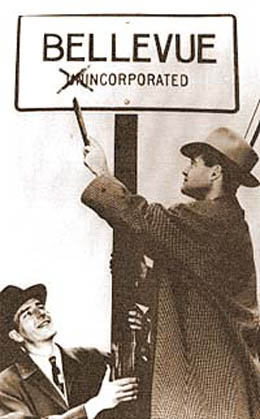On March 31, 1953, the City of Bellevue is incorporated. Bellevue is located on the east side of Lake Washington. It will become the fifth largest city in Washington and the metropolitan hub for business and transportation on the Eastside. At the time of incorporation, Bellevue has 5,950 residents.
After the end of World War II, Bellevue began a rapid transformation as more and more people moved to the once-sleepy town. The community had new schools, new housing developments, a better water supply, miles of roads, and a burgeoning business community, but no governing control to fit all these different pieces together. In 1951, voters were asked to incorporate the City of Bellevue, but the provision was defeated, 92 to 72.
City boosters, led by Chamber of Commerce President Sam Boddy, spent the next two years convincing the community that local citizens were the best people to plan Bellevue's future and that incorporation was the only way to insure this. An independent study predicted that Bellevue's growth would continue unabated, and that incorporation was the only way, "to prevent a way of life from deteriorating."
The issue went back to the ballot box. On March 24, 1953, voters approved incorporation by a vote of 885 to 461, and on March 31, Bellevue became a third-class city, with a council-manager form of government.
Bellevue's first city council was composed of Charles Bovee, Phil Bessor, Thomas Dann, George Kardong, Melvin Love, Alden Hanson, and Albert Prince. They hired Evan E. Peterson as the first city manager; and elected Charles Bovee as the first mayor. Bovee had pushed for incorporation as early as 1931, and his wife Jenny had been a prime mover in starting the city's Strawberry Festival in 1925.

